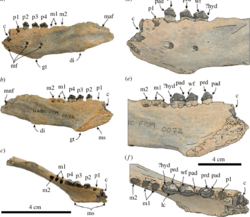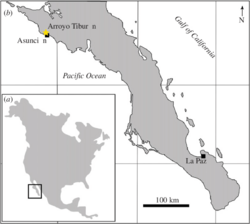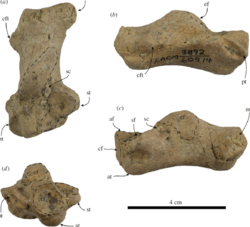Biology:Nanodobenus
| Nanodobenus | |
|---|---|

| |
| The left mandibular fossil of N. arandai, including articulated teeth | |
| Scientific classification Error creating thumbnail: Unable to save thumbnail to destination
| |
| Domain: | Eukaryota |
| Kingdom: | Animalia |
| Phylum: | Chordata |
| Class: | Mammalia |
| Order: | Carnivora |
| Clade: | Pinnipedia |
| Family: | Odobenidae |
| Genus: | †Nanodobenus Velez & Salinas-Marquez, 2018 |
| Species: | †N. arandai
|
| Binomial name | |
| †Nanodobenus arandai Velez & Salinas-Marquez, 2018
| |
Nanodobenus is an extinct genus of pinniped that lived approximately 15.97 to 7.246 mya[1] during the Miocene in what is now Baja California Sur, Mexico. It belonged to the family Odobenidae, the only extant species of which is the walrus.
Discovery
N. arandai is known from a partially complete left mandible and a right calcaneum bone, discovered in the Torgugas Formation in Mexico.[2]
Description
Nanodobenus were more similar in appearance to modern fur seals and sea lions than walruses. They lacked the long tusks of walruses, and were more slender and smaller than their modern relatives.
Despite the general increase in body size of odobenids from the Miocene to Pliocene, Nanodobenus were the smallest members of Odobenidae. Individuals were likely around 1.65 metres (5.4 ft) long, indicating the possibility that this genus occupied a different niche from contemporary odobenids.
Taxonomy
Nanodobenus is a relatively basal species of odobenid.
References
- ↑ "†Nanodobenus arandai Velez and Salinas-Marquez 2018". http://www.fossilworks.org/cgi-bin/bridge.pl.
- ↑ Velez-Juarbe, J.; Salinas-Marquez, F. (August 2018). "A dwarf walrus from the Miocene of Baja California Sur, Mexico". Royal Society Open Science 5 (8): 180423. doi:10.1098/rsos.180423. PMID 30225030.
Wikidata ☰ Q67153819 entry
 |



